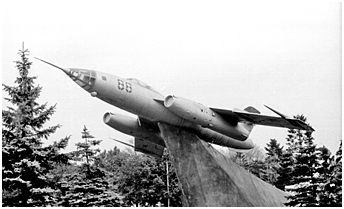
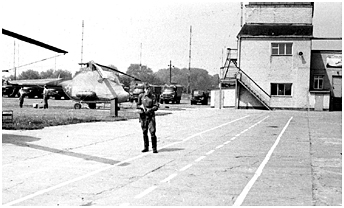 Once the historic settlement of the factories of the famous German engineer Bücker, Rangsdorf, located south of Berlin, housed the
83nd Separate Signal and Automatic Control Systems Regiment (OPS ASU) and the 825th Aviation Repair Plant (ARZ), a helicopter
maintenance unit that specialized in Level 2 maintenance (or intermediate periodic maintenance)
of Mil' Design Bureau Mi-2 'Hoplite' and Mi-8 'Hip' helicopters.
The airfield sometimes was used by other units. Thus, a witness declared that Mi-4 helicopters of the third helicopter squadron from the
226.OSAP based at Sperenberg conducted autorotation training sessions at Rangsdorf.
Incidentally, this base also was a storage site for all the machines destroyed in
accidents or doomed to extinction by obsolescence.
The wrecks and pieces of various aircraft and helicopters that operated during the heyday of Soviet aviation in the GDR or that were
used as targets on the firing ranges of East Germany, were rotting in this open dump. Aircraft types like Yak-27 'Mangrove', Yak-28
'Brewer', Il-28 'Beagle', MiG-17, -23, -25, -27, an Il-14 'Crate ' nose or ground-to-air missiles of the S-75 or SA-75 (SA-2 'Guideline')
SAM systems were waiting for the Russian scrap dealers. The helicopters were not spared, as some Mi-2 'Hoplite' and old Mi-8T 'Hip-C'
and Mi-8TV 'Hip-E' were also reduced to pieces at Rangsdorf.
Once the historic settlement of the factories of the famous German engineer Bücker, Rangsdorf, located south of Berlin, housed the
83nd Separate Signal and Automatic Control Systems Regiment (OPS ASU) and the 825th Aviation Repair Plant (ARZ), a helicopter
maintenance unit that specialized in Level 2 maintenance (or intermediate periodic maintenance)
of Mil' Design Bureau Mi-2 'Hoplite' and Mi-8 'Hip' helicopters.
The airfield sometimes was used by other units. Thus, a witness declared that Mi-4 helicopters of the third helicopter squadron from the
226.OSAP based at Sperenberg conducted autorotation training sessions at Rangsdorf.
Incidentally, this base also was a storage site for all the machines destroyed in
accidents or doomed to extinction by obsolescence.
The wrecks and pieces of various aircraft and helicopters that operated during the heyday of Soviet aviation in the GDR or that were
used as targets on the firing ranges of East Germany, were rotting in this open dump. Aircraft types like Yak-27 'Mangrove', Yak-28
'Brewer', Il-28 'Beagle', MiG-17, -23, -25, -27, an Il-14 'Crate ' nose or ground-to-air missiles of the S-75 or SA-75 (SA-2 'Guideline')
SAM systems were waiting for the Russian scrap dealers. The helicopters were not spared, as some Mi-2 'Hoplite' and old Mi-8T 'Hip-C'
and Mi-8TV 'Hip-E' were also reduced to pieces at Rangsdorf.
 Les hangars de Rangsdorf en 1975. © A.Pouchkarev.
Les hangars de Rangsdorf en 1975. © A.Pouchkarev.
Rangsdorf hangars in 1975. © A.Pushkarev.
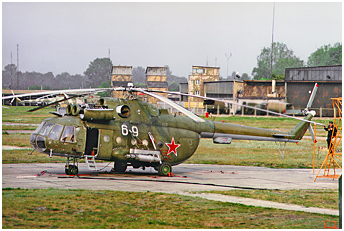
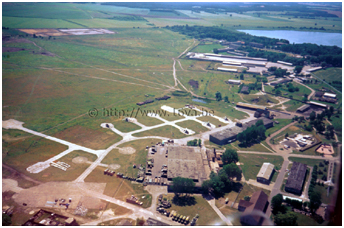 From 1991 on, aircraft that clearly had been withdrawn from active duty in the VVS already a long time ago, began to appear in
considerable numbers at Rangsdorf. The arrival of these aircraft was not accidental. In order to improve the realism of the Soviet firing
ranges in the GDR, decommissioned aircraft, trucks or missiles were scattered on the ranges. Some aircraft could have come directly from
USSR by rail, but that remain to be confirmed.
An airfield mockup with a hard sand track was reproduced at Wittstock-Forst on the huge training and firing range near Wittstock.
Several decommissioned aircraft were standing in dispersals to be used as targets. Rumors even have implied that some aircraft made their
final landing on the firing range runway itself (See pages > Airbases and > LABS at Gadow-Rossow).
When the great Russian evacuation of Germany began in 1991, Rangsdorf had the dubious honor of becoming the gathering place of all the
aircraft and missile wrecks doomed for destruction that were scattered up to then on the soil of East Germany.
From 1991 on, aircraft that clearly had been withdrawn from active duty in the VVS already a long time ago, began to appear in
considerable numbers at Rangsdorf. The arrival of these aircraft was not accidental. In order to improve the realism of the Soviet firing
ranges in the GDR, decommissioned aircraft, trucks or missiles were scattered on the ranges. Some aircraft could have come directly from
USSR by rail, but that remain to be confirmed.
An airfield mockup with a hard sand track was reproduced at Wittstock-Forst on the huge training and firing range near Wittstock.
Several decommissioned aircraft were standing in dispersals to be used as targets. Rumors even have implied that some aircraft made their
final landing on the firing range runway itself (See pages > Airbases and > LABS at Gadow-Rossow).
When the great Russian evacuation of Germany began in 1991, Rangsdorf had the dubious honor of becoming the gathering place of all the
aircraft and missile wrecks doomed for destruction that were scattered up to then on the soil of East Germany.

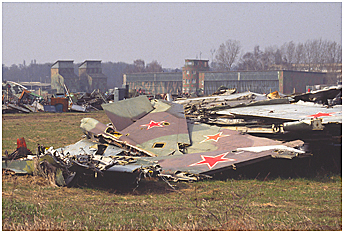 Moreover, other dismantling sites were discovered here and there.
A great deal of practice ammunition as well as many older first-generation RS-2US air-to-air missiles were seen at the 3125th Aviation
Rocket Armament and Ammunition Depot at Biesenthal. A small dump with simulated tactical nuclear bombs used in training was even found
there by chance!
We do not know however if other scrap metal storage and destruction sites existed elsewhere on the territory of the former GDR.
Moreover, other dismantling sites were discovered here and there.
A great deal of practice ammunition as well as many older first-generation RS-2US air-to-air missiles were seen at the 3125th Aviation
Rocket Armament and Ammunition Depot at Biesenthal. A small dump with simulated tactical nuclear bombs used in training was even found
there by chance!
We do not know however if other scrap metal storage and destruction sites existed elsewhere on the territory of the former GDR.
On the other hand, local dumps existed on many bases, but their size was highly variable. The one at Finsterwalde was perhaps the most
interesting. It included various airframes and other elements that gave a partial picture of the operational past of the airfield.
| Rangsdorf Airfield In the spring of 1935, the Reich's Ministry of Aviation (RLM) decided on Rangsdorf as the site for construction of an airfield and a platform for seaplanes (on the shores of the Rangsdorfer See). The Bücker-Flugzeugbau GmbH company founded on October 3, 1933 in Berlin-Johannisthal left this field for Rangsdorf in the fall of 1935 to produce Bü 131 'Jungmann' and Bü 133 'Jungmeister' models. The airfield was officially designated Reichssportflughafen Rangsdorf (Reich's Sports Airfield Rangsdorf). The Reichsschule für Motorflug (Reich's Motorized Flight School) was also based there from 1936 on. The Bücker factory ceased its operations on April 20, 1945. The site was captured by the Red Army without resistance two days later. Some fighter units flying on La-5/-7 were stationed there between 1945 and 1946, when the 201.ZAM, a maintenance unit later renamed the 825.ARZ, moved there in August. Activities began with the revision of piston engines as well as the maintenance and the modifications of the following aircraft types: IL-2/-10, La-5/-7/-9, Po-2, Pe-2 and Yak-3 /-11/-12. Work on Mi-2 helicopters began in 1972, while the Mi-8T started to arrive in 1981. Not only did the 825.ARZ overhaul the 'Hip' helicopters from the Group of Soviet Forces in Germany. It also took care of the Mi-8 from the Northern (Poland) and Central (Czechoslovakia) groups of Soviet Forces. Nearly 200 aircraft, helicopter and missiles were destroyed on the site starting in 1991. The last elements of the Western Group of Forces still present in Rangsdorf left the scene in 1994. From the Bücker museum site at Rangsdorf and Rote Plätze by S.Büttner & L.Freundt. |
 |
RANGSDORF PHOTO PAGE |  |
 |
VARIOUS DUMPS PHOTO PAGE |  |
 |
Plan du site - Sitemap |  |
